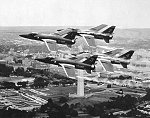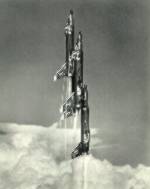|
N AVAL AVIATION NEWS |
|||||
|
TWENTY YEARS WITH THE BLUE ANGELS Published in the June 1966 issue of Naval Aviation News Page 2 |
|||||
|
Twenty years of service in the Navy usually means retirement. But not for the Blue Angels who celebrate their 20th anniversary this month. The Navy's Flight Demonstration Team is not about to retire. Its members still fly high, fast and handsome. In their first 20 years, they have given over 1,200 performances and flown some 10,000 practice sessions. For the past five years, they have averaged 80 shows a year. More than 80 million people have seen the Blue Angels since they made their first public appearance in Grumman F6F Hellcats at the Southeastern Air Show at Jacksonville, Fla., in June 1946. Their largest single audience was 1,500,000 people at the dedication of the Mexico City Airport in 1964. The present team was reorganized and commended by the Congress of the United States when Representative Bob Wilson, California, read into the Congressional Record accolades given them by American and European publications for their performances at the 1965 International Air Show in Paris. Along with this praise, the Secretary of the Navy cited each of the pilots and awarded them Air Medals. Commander Bob Aumack, Officer in Charge, received the Distinguished Flying Cross. It can all be traced back to early 1946 when Chief of Naval Operations directed the organization of a Flight Exhibition Team within the Naval Air Advanced Training Command. LCdr. Roy M. "Butch" Voris was selected to lead the team. The first show was destined to make its impact and form the basis of a routine later seen by millions of people all over the world. In the early shows, the four Hellcats flew in tight formation and simulated shooting down a training plane with enemy markings. As the "enemy" descended trailing smoke, a dummy pilot was parachuted and promptly captured by a detachment of Marines. The present "diamond" formation began with the Hellcats. After the first show, the need was recognized for an appropriate name. According to Voris, the present name had a noteworthy origin. "One evening while reflecting on a coming trip to New York, we glanced through an issue of the New Yorker magazine. As we came upon the list of night spots, we saw the name of the well-known bistro, 'The Blue Angel.' Of course, it hit us all at the same time. It was an absolute natural." A short time later, the team changed to the faster F8F Bearcat, which they flew until their transition into jets. Their first jet was the Grumman F9F-2 Panther. These were used until the outbreak of the Korean Conflict. In June 1950 the Blue Angels were ordered to duty in a combat status aboard the carrier Princeton as the nucleus of VF-191. LCdr. Johnny Magda, then Blue Angel leader and Commanding Officer of the squadron, was the only active Blue Angel to lose his life in combat when he was shot down off the north coast of Korea in March 1951. In late 1951, the Chief of Naval Operations ordered the team reactivated and LCdr. Voris was again tapped as the leader. With another new plane, the F9F-5, the team worked out at Corpus Chrsti and held its first show since reactivation at the Memphis Mid-South Navy Festival in May 1952. During the winter of 1954-55, the team moved into the sweptwing F9F-8 Cougars. With the transonic Cougars, the team developed new maneuvers. Probably the most famous among these is the "Fluer-de-lis," performed near the end of the demonstration. In June 1955, the team moved its permanent base of operations from Corpus Christi to Pensacola. During the 1957-58 season, the Blue Angels made the transition to their present aircraft, the F-11 Tiger. During the 1963 season, the team introduced four new maneuvers. In that year they perfected the Diamond Landing (four planes); the Delta Landing (six planes); the Farvel, which is a low pass in the diamond formation with the leader inverted; and the Half Cuban Eight, performed by one of the solo pilots. The aircraft flown by the team have come a long way from the first F6F Hellcat flown in 1946. The F6F had a top speed of 400 mph and a service ceiling of 37,000 feet. The current F-11A can fly in excess of 800 miles an hour and normally operates above the F6F service ceiling. At 21,000 pounds, the F-11A is some five tons heavier than their second plane, the F8F Bearcat, which still holds the record for a recip from a standing start to 10,000 feet in 92 seconds. Led by Commander Bob Aumack during the 1965 season, the team set more records than any other group in their history. The team performed a record total of 87 times before more than 4,000,000 spectators while appearing throughout the United States, Europe, Iceland, Bermuda, the Bahama Islands, and the Caribbean. During their first European tour, the Blue Angels took part in the Paris International Aviation and Space Salon and received the only standing ovation of the four-day show. The line-up for the 1966 season follows: Commander Bob Aumack, Leader; Capt. Fred Craig, USMC, flying #2 on the right wing; Lt. Red Hubbard, Flying #3 of the left wing; Lt. Frank Mezzadri, flying #4 in the slot completes the diamond formation and LCdr. Dick Oliver, #5, and Lt. Norm Gandia, #6 flying the solo aircraft. |
|||||
|
During their 20 year history, the Blue Angels have performed in every major city in the U.S. |
Drawing heavy accolades from the international press after appearance in the 1965 Paris Air Show, the Blue Angels head home. |
||||
|
During their 20 year history, the Blue Angels have performed in every major city in the U.S. In background is Washington Monument. |
Straight up in tight diamond formation, the team nears the top of the loop. |
||||




